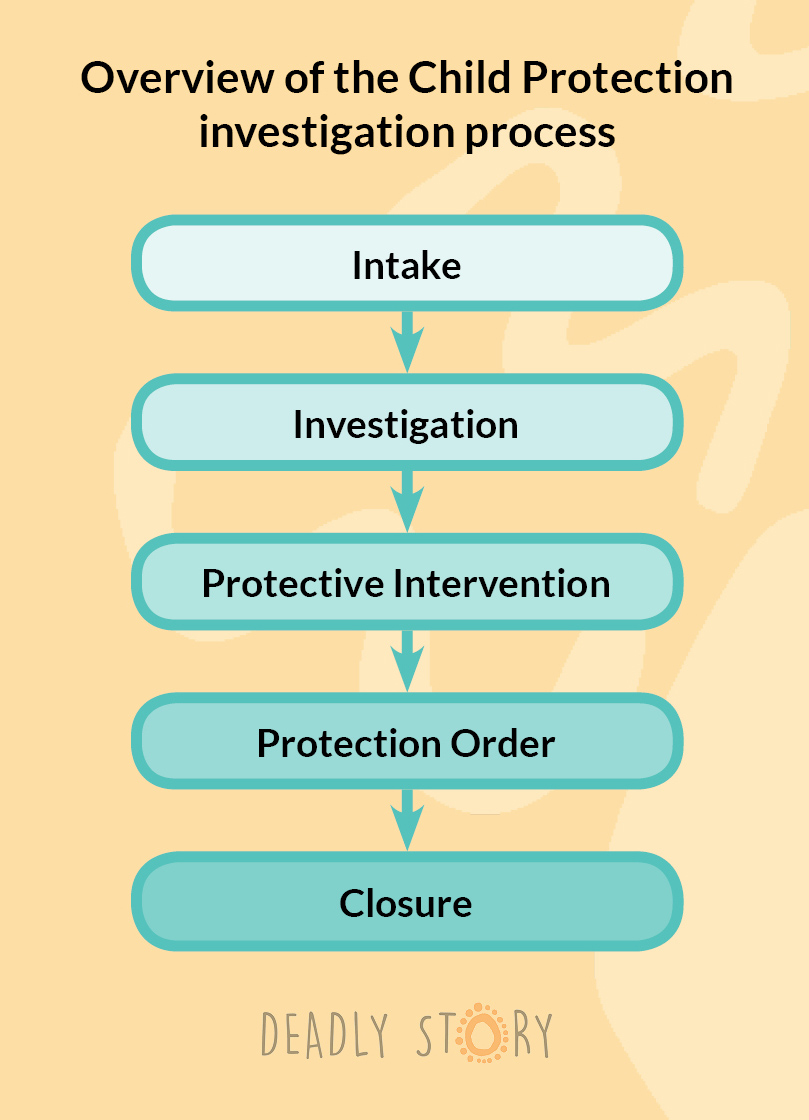The Victorian Child Protection Service works with children and young people at risk of harm or where families are found to be "unable or unwilling to protect them." Child Protection will get involved with a child and family in the following circumstances:
Child abandonment
If the child has been abandoned by their parents and cannot be located and there is no other suitable person that can be found who is willing and able to care for the child.
Death or incapacity of the child’s parents
If the child’s parents are dead or incapacitated, and there is no other suitable person who is willing and able to care for the child.
Child abuse and/or neglect
This forms the basis for the majority of cases brought to Child Protection. There are four main types of abuse:
- Physical abuse – this includes physical harm, injuries, being exposed to elements and weather
- Sexual abuse – this includes grooming, inappropriate touching, exposure to pornography
- Emotional or psychological abuse – this includes verbal abuse, put downs, threats, intimidation or experiencing other forms of mental abuse
- Neglect – where children are deprived of basic necessities and care (including food, clothing, shelter, medical care or treatment).
When a case of abuse or neglect of an Aboriginal child is reported Child Protection, they are required to notify the Aboriginal Specialist Advice and Support Service (ACSASS). This is a service that provides advice to Child Protection about the cultural needs and wellbeing of Aboriginal children. ACSASS seeks to make sure that Aboriginal children live in a culturally safe environment, can grow up with their Aboriginal family and remain connected with their Aboriginal Community in the event that the child is unable to safely remain with their family.
The diagram below provides an overview of the stages of a Child Protection investigation into an alleged case of child abuse or neglect. The tabs below provide more information about each stage and include an overview of the involvement of the Aboriginal Specialist Advice Support Service.

-
Intake

-
The intake phase commences when a report of an alleged child abuse and neglect is made to Child Protection. Child Protection is required to consult with the Aboriginal Child Specialist Advice and Support Service to assess the information related to the child's safety, well-being and cultural needs. Intake involves Child Protection receiving reports and deciding how to respond, providing advice to the reporters, helping children and families access support services and where appropriate, making referrals. Intake concludes when the report is transferred for investigation or closed (with or without advice or referral).
-
Investigation

-
This is the phase where Child Protection staff find out whether the child is in need of 'protection.' They do this by gathering information, meeting with the child and family, professionals and workers. Child Protection are required to do this work with advice and participation from the Aboriginal Child Specialist Advice and Support Service.
The key aims of the 'investigation' phase are to find out:
- how serious the reported concerns are and what evidence is available to support this
- whether the child has suffered or is likely to suffer further harm
- whether the parents have protected or are likely to protect the child from harm
- whether Child Protection needs to issue a protection order to meet the best interests of the child
- whether other supports are needed to help support the family.
If there is enough evidence found to support the claims made in the initial report, then the report is said to be 'substantiated.' At this point, 'protective intervention' begins (see next section).
-
Protective Intervention

-
This phase is about the action Child Protection takes after they have confirmed that a child has been abused or neglected. A local Aboriginal Child Specialist Advice and Support Service (ACSASS) team must be consulted to help planning this action.
The action or 'Protective Intervention' Child Protection may take could be referring the family to services for support, assigning a case manager or they may recommend the case be referred to the courts for an order (see next section).
There are 3 possible outcomes in the protective intervention phase:
- Child protection intervention is no longer required and the case is closed
- There is evidence to support a 'protection order' being put in place
- A protection application does not result in a protection order and the case is closed.
-
Protection Order

-
After a protection application has been made, the Children's Court will determine if there's enough evidence to suggest that the child is in need of protection - if so, then a Protection Order will be issued to maintain the child's safety and wellbeing.
A Protection Order (sometimes referred to as a Court Order) is an instruction issued by the children's court about the care of a child that must be followed.
Through this phase, the Aboriginal Child Specialist Advice and Support Service (ACSASS) continues to provide their support to Child Protection with regards to major decisions and actions concerning Aboriginal children.
Protection Orders are made for the following reasons:
- To reduce risk of abuse and neglect to the child
- To promote the child’s safety and development, provide for their present and future care and wellbeing, and achieving an ongoing care arrangement that creates a sense of belonging
- To implement the child and family's case plan, including setting goals, tasks and timelines and monitoring its progress to keep the plan on track
- If the goal is to return the child to a parent or family member, to ensure that the family is empowered to function independently.
